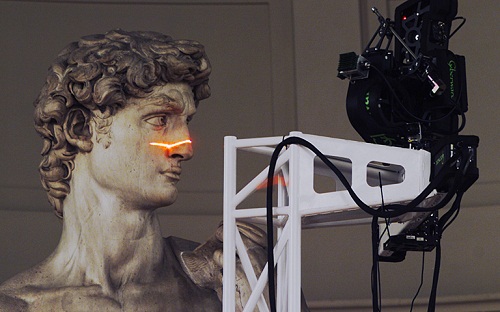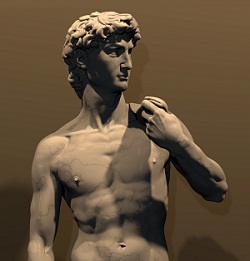Vrunda Rathod was a student at the University of California who studied Biomedical Engineering in the fall of 2004. She enjoys frequenting museums to experience art on a first hand basis.
With the recent boom in digital technology, science has opened the doors to historical secrets. For years, engineering has paved the path to knowledge. Now, it has come to the aid of aesthetes, uncovering the mysteries hidden for us by history’s master artists. 3D scanning provides art historians with virtual models of sculptures whose accuracy parallels that of microscopic inspection. This allows art historians to focus on detailed analysis, which can help elucidate the methods of the masters. Also, virtual images can be used to create a worldwide archive of art, allowing historians to analyze artwork at their leisure, without leaving the comforts of home. Furthermore, a worldwide archive permits thousands of people to view pieces simultaneously. Pioneering projects in this field include Stanford’s recent scanning project of Michelangelo’s David and IBM’s Florentine Pieta project. This article provides an overview of the processes used to scan these pieces, as well as the problems and innovative solutions that lead to some amazing results.
Meeting Michelangelo
Take a closer look at Michelangelo’s David. Originally, the David was to stand atop a flying buttress at the Florence Cathedral, where viewers would have to gaze upward at the masterpiece. To account for this skewed perspective, Michelangelo extended David’s right arm past mid-thigh, further than that of the normal male. At ground level, the arm seems abnormally long, but when viewed at the intended line of sight, the arm appears to be of normal length. Such details reveal Michelangelo’s genius. Although prominent aspects of a sculpture are easily noticeable, more minute details are often indiscernible by the naked eye.
These minute details often make all the difference. In a world of countless duplicates, it has become important for the art historian to be able to distinguish the art of a master from a common forgery. In addition, the smallest details can often hide the secret to the method and meaning behind each great work of art. It is the quest for particulars that has turned many art historians to science.
And in response, engineers have created a tool that will allow art historians to scrutinize sculptures centimeter by centimeter: 3D scanning. This scanning allows art historians to build an interactive virtual image capable of demonstrating the full beauty of a work, while giving perspectives often unattainable in real life. In fact, 3D scanning is so precise, each chisel mark made centuries ago can be measured and mapped.
Backstage
While 3D scanning makes life much easier for art historians, it often leaves engineers with their hands full; constructing a virtual model is no easy task. The majority of pieces targeted for these projects are celebrated works located in highly frequented museums. Because of the constant stream of admirers, isolating pieces in order to obtain digital photographs is difficult. Thus, engineers must resort to evening scanning sessions not to interfere with museum spectators [1]. Additionally, the space afforded in museums for each piece is modest, at best. This means that large units are impractical, if not unusable.
Various methods have been developed to address these issues. IBM has developed separate pieces of equipment connected and controlled by various pulleys to accommodate the meager amount of space available to them while scanning the Pieta. Alternately, Stanford researchers constructed large movable platforms on which to position the lights and camera, much like a film set.
The largest problem, however, stems from the overwhelming amount of data needed to reconstruct an accurate image. Providing a scan for academic research of just one sculpture involves more data than can be held in one computer, as was the case during Stanford’s scanning of the David. Thus, a system of constant data transfer was required to ensure adequate space on the hard drive for the following night’s collection.
Step 1: Say Cheese
As with any scanning project, the initial step in 3D model construction is to scan the target object. Due to the novelty of this project, however, few preexisting scanning devices were available. Often, a device is constructed solely for one project, in the hopes of future marketing options. In response to a request by Jack Wasserman, a professor at Temple University in Philadelphia, IBM constructed its own scanning apparatus, utilizing Virtuoso’s customized ShapeCamera. Additional lighting and hardware were also acquired to produce an innovative scanning system. Stanford created its own device, the Large Statue Scanner, for its Digital Michelangelo Project. Although designed by Stanford graduates, Cyberware Inc. of Monterey, CA, constructed the device.
Method Behind the Madness, Part I
Scanning the image involves a series of alternative forms of digital photography. Basic technology and methods are similar for many of the existing systems. Most 3D scanning systems consist of several light sources, a digital black and white camera, a color camera, and a weak laser that projects a grid onto the statue [2]. These components are arranged in a manner that parallels a movie set. The lighting is focused on an area as small as a few square inches, and several camera angles are employed to ensure optimal data acquisition.
A laser then projects vertical lines onto the surface of the sculpture while several cameras take black and white digital pictures from varying angles (see Fig. 1). The gridlines provide engineers with data points that when connected create a complete 2D picture. Next, the color camera photographs the same area from the same angle to provide depth. These new data points lie above and below the plane of the 2D picture. When connected, they combine to form a finished 3D form. Each scan is done with selective lighting to provide shadows and highlights of each section. A typical scan of this type covers 20 square centimeters with 10,000 pixels per scan. Scanned pictures overlap to allow for piecewise assembly.
The laser projects an irregular pattern on the statue from a distance and the digital photographs are recorded. This provides more data points so that range maps can have smoother flow. Furthermore, this aids in later alignment of the digital images. Thus, the entire sculpture is photographed in vertical sections and the collection of these images constitutes the raw data, which is used in the reconstruction of a 3D image.
Step 2: Developing the Film
It is important to remember that digital images are merely collections of data points (usually representing intensities) that have been processed by several algorithms. Since the scanning process only records intensities, it is still necessary to convert these data into a 3D model. Due to the vast amount of raw data collected by the cameras, image conversion is a lengthy process. Nevertheless, engineers have helped to remedy the process by developing several algorithms that expediently create ultra high quality images, with, of course, the help of some high power computing.
Method Behind the Madness, Part II
Before the raw data can be processed into the final image, it must first be prepared by an algorithm to filter out data redundancies or discrepancies. The reconstruction of the image begins with a manual alignment of the digital scans, much like putting the pieces of a puzzle together. The puzzle is constructed via correlation of the black and white images, the color images, and the laser projections. This creates several range maps: rough connect-the-dots pictures that can then be improved by an IBM iterated closest point algorithm, or IPC.
To further filter the image, an image-based registration method is then applied. This method uses computed maps to back project the image, thereby reducing the distance between the data points. Such algorithms use various methods to make the original lines connecting the data points flow more naturally from one point to another, basically creating a smoother curve on the final model. Next, the images are subject to conformational smoothing, where irregular elements are eliminated by computing several overlapping maps at one time. This results in an intermediate image called a mesh.
Next, the IBM program uses a ball pivoting algorithm (BPA) to process the data into triangular slices and to create an exponential interpolation of the triangle mesh data. Essentially, by chopping the original mesh into smaller pieces, the BPA can reconstruct it into an image with better resolution than its original counterpart. In order for this reprocessed mesh to be useful, however, color and texture must now be applied. Using the pixel size and the intensity at each pixel, the reflectance, or albedo, can be calculated for red, blue, and green bands, basically determining exact color of each pixel. The texture of the statue is then generated using orthogonal projections. This results in a final, highly tuned product (see Fig. 2).
To Infinity and Beyond
Stanford and IBM are not alone in offering complete digital scanning systems at this time. Cyra Technologies, Cyberware, and Digibotics are just a few companies who offer the digital imaging component of the scanning systems. Many of the systems designed for academic or commercial use, however, are not yet technically sound [3]. Systems prided on their simplicity often comprise the quality of the virtual image, while highly defined 3D scans are often costly and extremely time consuming. For example, the Digital Michelangelo Project was completed over the course of several years at a cost of two million dollars. It is hoped that with the advancement of imaging technologies and the lowering cost of high power computing, a more widely available system will soon be available.
Avoid Pirated Copies
One of the driving forces behind the development of 3D scanning is the creation of a digital archive of important artworks [4]. These scanned images can also be placed on the internet, allowing for easy access to art historians worldwide. Stanford recently completed the scanning of the David and is now involved in scanning several similar statues. This digital archive could be used not only to detect the authenticity of a work, but also to learn much about the works themselves.
IBM’s portable 3D scanning was designed for analysis of Michelangelo’s Florentine Pieta. Michelangelo destroyed a section of the sculpture shortly after beginning. Years later, one of his students repaired the damage, but for years, no one knew which part of the statue was reconstructed. 3D scanning helped distinguish the master’s work from the pupil’s work. Using the 3D model, art historians were able to see the piece from infinitely many positions, permitting them to distinguish the original work from later additions.
The Moral of the Story
For ages, many scientists implemented the theory of reductionism in order to garner a greater understanding of something well known. For example, by dissecting a human body and examining the lungs, trachea, and sinus tracts that compose the respiratory system, a scientist can learn far more about the process by which we breathe than by simply observing air move in and out of the nose. Art history, it appears, is entering into a similar vein. With the help of 3D scanning, engineering is helping to usher centuries old works into the digital age.
References
[1] Bernardini, Fausot, Holly Rushmeirer, Ioana M. Martin, Jousha Mittleman, and Gaberial Taubin. “Building a Digital Model of Michelangelo’s Florentine Pieta.” IEEE Computer Graphics and Applications (Jan/Feb 2002): 59-67.
[2] M. Levoy. “The Digital Michelangelo Project.” Stanford Computer Graphics Laboratory. 2000. Web. <http://graphics.stanford.edu/projects/mich/>
[3] C. Rocchini., P. Cignoni, C. Monatoni, P. Pingi and R. Scopigno. “A Suite of Tools for the Management of 3D Scanned Data” Institute of Science and Technology. 2000. http://citeseerx.ist.psu.edu/viewdoc/summary?doi=10.1.1.28.7099.
[4] M. Levoy. “The Digital Michelangelo Project” Proc. 2nd International Conference of 3D Digital Imaging and Modeling(1999): 2-13.
 Marc Levoy/Digital Michelangelo Project
Marc Levoy/Digital Michelangelo Project



